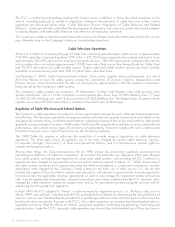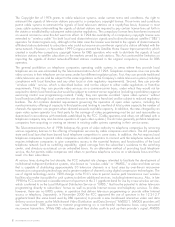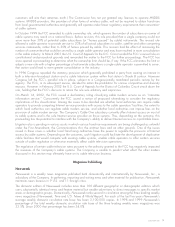Washington Post 2002 Annual Report Download - page 18
Download and view the complete annual report
Please find page 18 of the 2002 Washington Post annual report below. You can navigate through the pages in the report by either clicking on the pages listed below, or by using the keyword search tool below to find specific information within the annual report.Washingtonpost.Newsweek Interactive faces competition from many other Internet services, particularly services that
feature national and international news, as well as from alternative methods of delivering news and information. In
addition, other Internet-based services are carrying increasing amounts of advertising and over time such services
could also adversely affect the Company’s print publications and television broadcasting operations, all of which
rely on advertising for the majority of their revenues. Several companies are offering online services containing
information and advertising tailored for specific metropolitan areas, including the Washington, D.C. metropolitan
area. For example, Digital City (a unit of AOL Time Warner) produces Digital City Washington, DC, which is part of
AOL’s nationwide network of local online sites. National online classified advertising is becoming a particularly
crowded field, with competitors such as Yahoo! and eBay aggregating large volumes of content into a national
classified database covering a broad range of product lines. Other competitors are focusing on vertical niches in
specific content areas: autos.msn.com (which is majority owned by Microsoft), AutoTrader.com and Autobytel.com,
for example, aggregate national car listings; Realtor.com aggregates national real estate listings; while Mon-
ster.com, HotJobs.com (which is owned by Yahoo!) and CareerBuilder.com (which is jointly owned by Gannett,
Knight-Ridder and Tribune Co.) aggregate employment listings.
The Herald circulates principally in Snohomish County, Washington; its chief competitors are the Seattle Times and
the Seattle Post-Intelligencer, which are daily and Sunday newspapers published in Seattle and whose Snohomish
County circulation is principally in the southwest portion of the county. Since 1983 the two Seattle newspapers have
consolidated their business and production operations and combined their Sunday editions pursuant to a joint
operating agreement, although they continue to publish separate daily newspapers. The Enterprise Newspapers are
distributed in south Snohomish and north King Counties where their principal competitors are the Seattle Times and
The Journal Newspapers, a group of weekly controlled-circulation newspapers. Numerous other weekly and semi-
weekly newspapers and shoppers are distributed in The Herald’s and The Enterprise Newspapers’ principal circula-
tion areas.
The circulation of The Gazette Newspapers is limited to Montgomery, Prince George’s and Frederick Counties and
parts of Carroll, Anne Arundel and Howard Counties, Maryland. The Gazette Newspapers compete with many
other advertising vehicles available in their service areas, including The Potomac and Bethesda/Chevy Chase
Almanacs, The Western Montgomery Bulletin, The Bowie Blade-News, The West County News and The Laurel
Leader, weekly controlled-circulation community newspapers, The Montgomery Sentinel, a weekly paid-circulation
community newspaper, The Prince George’s Sentinel, a weekly controlled-circulation community newspaper (which
also has a weekly paid-circulation edition), The Montgomery and Prince George’s Journals, daily paid-circulation
community newspapers, and The Frederick News-Post, a daily paid-circulation community newspaper. The Southern
Maryland Newspapers circulate in southern Prince George’s County and in Charles, Calvert and St. Mary’s
Counties, Maryland, where they also compete with many other advertising vehicles available in their service areas,
including the Calvert County Independent and St. Mary’s Today, weekly paid-circulation community newspapers.
The advertising periodicals published by Greater Washington Publishing compete both with many other forms of
advertising available in their distribution area as well as with various other free-circulation advertising periodicals.
The Company’s television stations compete for audiences and advertising revenues with television and radio stations
and cable television systems serving the same or nearby areas, with direct broadcast satellite services and to a lesser
degree with other video programming providers and with other media such as newspapers and magazines. Cable
television systems operate in substantial portions of the Company’s broadcast markets where they compete for
television viewers by importing out-of-market television signals and by distributing pay-cable, advertiser-supported
and other programming that is originated for cable systems. In addition, direct broadcast satellite (‘‘DBS’’) services
provide nationwide distribution of television programming (including in some cases pay-per-view programming and
programming packages unique to DBS) using small receiving dishes and digital transmission technologies. In
November 1999, Congress passed the Satellite Home Viewer Improvement Act, which gives DBS operators the
ability to distribute the signals of local television stations to subscribers in the stations’ local market area (‘‘local-into-
local’’ service), although since April 2000 the DBS operator has been required to obtain the consent of each local
television station included in such a service. All of the Company’s television stations are currently being distributed
locally by satellite. Under an FCC rule implementing provisions of this Act, since January 2002 DBS operators that
offer local-into-local service have been required to carry all full-power television stations that request such carriage in
the markets in which the DBS operators have chosen to offer local-into-local service. The FCC has also adopted rules
that require certain program-exclusivity rules applicable to cable television to be applied to DBS operators, although
certain of these rules, primarily relating to sports blackouts, are subject to reconsideration by the FCC. The Satellite
Home Viewer Improvement Act also continues restrictions on the transmission of distant network stations by DBS
16 THE WASHINGTON POST COMPANY
























